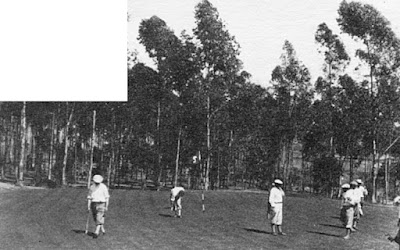 |
| Fairway Country Club clubhouse, 1926 (Arrowhead Magazine photo) |
Among the many Orange County endeavors lost to time was The Fairway Country Club. It was located on Lot 36 of Cerro Villa Heights -- a tract laid out in the foothills by the Jotham Bixby Co. in 1920 and now a part of Villa Park. In modern terms, the Club grounds were roughly bounded by Mesa Drive on the north, Cannon Street on the east, and the line of Sycamore Street (if it continued northward) on the west. I extended to the south about as far as the current site of 9852 Leatrice Dr.
The Club had its origins in 1922, but the first mentions in local newspapers -- mainly ads for afternoon golf lessons -- didn't begin to appear until Summer 1923. In October, the C. B. Berger Co. -- sales agent for the Bixby holdings in the Cerro Villa area -- also began running ads touting the Club as one of the advantages of buying land nearby.
 |
| Scene from Fairway's golf course, 1926 (Arrowhead Magazine photo) |
However, the Club’s nine-hole golf course didn’t actually open until Feb. 22, 1924. A grand opening tournament was held that day for the William A. Dolan Cup (named for the Club's president). The other highlight of the day was a match game between Anaheim Mayor William Stark and Orange Mayor Gunther.
The course was designed by Anaheim golf pro Joe Szarfinski who soon after was hired as the golf pro for the Orange County Country Club. He had also designed the municipal golf course in San Diego's Balboa Park.
 |
| Inside the Fairway Clubhouse, 1926 (Arrowhead Magazine photo) |
The Fairway Country Club's clubhouse wasn't built yet when the course opened, and early Club events like board meetings and dances were usually held at the Elks' Lodge in Anaheim.
By May 1925 the former home of George B. Bixby had been converted into a clubhouse and the Club began to have events with entertainment there. Jack Armstrong served as the resident “golf pro.”
The Fairway Land Co. was the holding company for the Club and its board was largely composed of community and business leaders from nearby cities.
 |
| (Map courtesy Lisa Baldwin) |
In the July 1926 edition of the Union Pacific Railroad's Arrowhead Magazine, Anaheim Parks Superintendent Warren Ashleigh wrote,
"This club, located seven and one-half miles east of the City [of Anaheim] in the foothills, on 250 acres . . . is one of the finest recreational spots in Southern California. Its membership is made up of 125 leading business men and women from the cities of Anaheim and Orange. The Clubhouse, surrounded by beautiful flowers and trees, equipped with splendid furnishings, giving a homey appearance, is used largely for the social functions of the club and its members.
"The Manager of the grounds is at the Professional House at all times. Under his excellent supervision, the nine-hole golf course is kept in splendid condition and many business men spend the afternoons at this beautiful spot.
"An expansion program is being worked out which will give the nine holes 3,000 yards, and plenty of land for home sites., and another nine-hole course. The club grounds, located as they are on these beautiful hills, have a view of the surrounding country that is unsurpassed. On a clear day one is able to see the ocean and Catalina Island, seventy-five miles in the distance."
On Feb. 1, 1927, Club president S. J. Flour announced plans for major improvements, including extending the course by 3,000 yards, increasing the par for the course to 35, installation of a sprinkler system (accomplished a few months later), and added capacity to accommodate more players.
 |
| One of the greens at Fairway, 1926 (Arrowhead Magazine photo) |
By early March 1927, there was talk that a big financial firm from Los Angeles was angling to buy the Club. The unidentified firm supposedly wanted to add swimming pools, lawn tennis, polo fields, a riding academy, a new clubhouse, and an expansion of the golf course to a full eighteen holes.
Indeed, in July 1927, the Fairway Country Club was sold for $95,000 to a syndicate of Los Angeles men, headed by T. C. Brady and F. G. Hoffine. Their initial goals were to build a lavish new clubhouse and to expand the course to eighteen holes under the guidance of golfer and course expert Norman McBeth and golf course architects William Bell and Max Baer.
 |
| The caretaker's house at Fairway, 1926 (Arrowhead Magazine photo) |
The new owners renamed the place the Valencia Vista Country Club. The board of the Valencia Vista Co. – the new holding company for the Club -- was again a "who's who" of central Orange County, including Willard Smith, Osmun & M.C. Pixley, Nels Edwards, Keller Watson, W. O. Hart, J. S. Flour, etc.
But for some reason the Club soon faded away – even before the 1929 stock market crash and economic depression that likely would have scuttled it anyway.
 |
| Fairway Country Club clubhouse, 1926 (Santa Ana Register photo) |
(Thanks to Lisa Ackerman Baldwin for asking about this place and to Roger Fitschen for continuing to dig for more on this subject. Thanks also to Steve Faessel for pointing out the Arrowhead blurb which I had in my personal library, but which I'd overlooked for two years!)

No comments:
Post a Comment